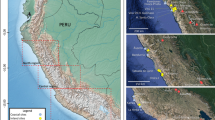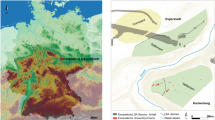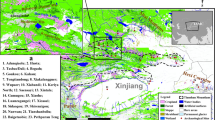Abstract
The archaeological record shows that large pre-Inca agricultural systems supported settlements for centuries around the ravines and oases of northern Chile’s hyperarid Atacama Desert. This raises questions about how such productivity was achieved and sustained, and its social implications. Using isotopic data of well-preserved ancient plant remains from Atacama sites, we show a dramatic increase in crop nitrogen isotope values (δ15N) from around ad 1000. Maize was most affected, with δ15N values as high as +30‰, and human bone collagen following a similar trend; moreover, their carbon isotope values (δ13C) indicate a considerable increase in the consumption of maize at the same time. We attribute the shift to extremely high δ15N values—the highest in the world for archaeological plants—to the use of seabird guano to fertilize crops. Guano—‘white gold’ as it came to be called—thus sustained agricultural intensification, supporting a substantial population in an otherwise extreme environment.
This is a preview of subscription content, access via your institution
Access options
Access Nature and 54 other Nature Portfolio journals
Get Nature+, our best-value online-access subscription
$29.99 / 30 days
cancel any time
Subscribe to this journal
Receive 12 digital issues and online access to articles
$119.00 per year
only $9.92 per issue
Buy this article
- Purchase on Springer Link
- Instant access to full article PDF
Prices may be subject to local taxes which are calculated during checkout




Similar content being viewed by others
Data availability
The authors declare that all data generated or analysed during this study are included in this published article (and its Supplementary Information files).
References
Ugalde, P. C. et al. 13,000 years of sociocultural plant use in the Atacama Desert of northern Chile. Veget. Hist. Archaeobot. https://doi.org/10.1007/s00334-020-00783-1 (2020).
Santoro, C. et al. Proyectos de irrigación y la fertilización del desierto. Estud. Atacameños. 16, 321–336 (1998).
Parcero-Oubiña, C. et al. Sistemas agrohidráulicos en el Loa Superior: el caso de Topaín. Boletín de. la Soc. Chil. de. Arqueología 46, 23–42 (2016).
Sandor, J. A. & Homburg, J. A. Anthropogenic soil change in ancient and traditional agricultural fields in arid to semiarid regions of the Americas. J. Ethnobiol. 37, 196–217 (2017).
Segura, C., Vidal-Elgueta, A., Maldonado, A., Uribe, M. Soil use in pre-Hispanic and historical crop fields in the Guatacondo Ravine, northern Chile (2400 y bp): a geoarchaeological and paleobotanic approach. Preprint at Geoarchaeology https://doi.org/10.1002/gea.21833 (2020).
Díaz, F. P., Frugone, M., Gutiérrez, R. A. & Latorre, C. Nitrogen cycling in an extreme hyperarid environment inferred from δ15N analyses of plants, soils and herbivore diet. Sci. Rep. 6, 22226 (2016).
Evans, R. D. & Ehleringer, J. R. Plant δ15N values along a fog gradient in the Atacama desert, Chile. J. Arid Environ. 28, 189–193 (1994).
DeNiro, M. J. & Hastorf, C. A. Alteration of 15N/14N and 13C/12C ratios of plant matter during the initial stages of diagenesis: studies utilizing archaeological specimens from Peru. Geochim. Cosmochim. Acta 49, 97–115 (1985).
Metcalfe, J. Z. & Mead, J. I. Do uncharred plants preserve original carbon and nitrogen isotope compositions? J. Archaeol. Method Theory 26, 844–872 (2019).
Szpak, P. & Chiou, K. L. A comparison of nitrogen isotope compositions of charred and desiccated botanical remains from northern Peru. Veg. Hist. Archaeobot 29, 527–538 (2019).
Killian-Galván, V., Oliszewski, N., Olivera, D. E. and Panarello, H. O. in Physical, Chemical and Biological Markers in Argentine Archaeology: Theory, Methods, and Applications (eds Kligmann, D. & Morales, M.) 39–51 (BAR International Series, Archaeopress, 2014).
Bogaard, A., Heaton, T. H. E., Poulton, P. & Merbach, I. The impact of manuring on nitrogen isotope ratios in cereals: archaeological implications for reconstruction of diet and crop management practices. J. Archaeol. Sci. 34, 335–343 (2007).
Bogaard, A. et al. Crop manuring and intensive land management by Europe’s first farmers. Proc. Natl Acad. Sci. USA 110, 12589–12594 (2013).
Szpak, P., Longstaffe, F. J., Millaire, J. F. & White, C. D. Stable isotope biogeochemistry of seabird guano fertilization: results from growth chamber studies with maize (Zea mays). PLoS ONE 7, e33741 (2012).
Szpak, P., Millaire, J.-F., White, C. D. & Longstaffe, F. J. Influence of seabird guano and camelid dung fertilization on the nitrogen isotopic composition of field-grown maize (Zea mays). J. Archaeol. Sci. 39, 3721–3740 (2012).
Frezier, A. A Voyage to the South-Sea and Along the Coasts of Chili and Peru, In the Years 1712, 1713, and 1714 (Jonah Bowyer, 1717).
Cieza de León, P. de. La Crónica del Perú (Lima, Pontificia Univ. Católica del Perú, 1984 [1553]).
De la Vega, G. Los Comentarios Reales de los Incas Vol. 1 (Sanmartí, 1919 [1609]).
de San Miguel, G. D. Visita hecha a la Provincia de Chucuito por Garci Diez de San Miguel en el año 1567 (ed. Soriano, W. E. Lima) (Casa de la Cultura del Perú, 1964 [1567]).
de Bibar, G. Crónica y Relación Copiosa y Verdadera de los Reinos de Chile. Colección de Escritores Coloniales (Editorial Universitaria, 1979 [1558]).
Sánchez, T. & Méndez-Quirós, P. El Ciclo del Guano en el Litoral del Tarapacá (Consejo Nacional de la Cultura y las Artes, 2011).
Mizutani, H. & Wada, E. Nitrogen and carbon isotope ratios in seabird rookeries and their ecological implications. Ecology 69, 340–349 (1988).
Cocks, M. P., Balfour, D. A. & Stock, W. D. On the uptake of ornithogenic products by plants on the inland mountains of Dronning Maud Land, Antarctica, using stable isotopes. Polar Biol. 20, 107–111 (1998).
Lucassen, F. et al. The stable isotope composition of nitrogen and carbon and elemental contents in modern and fossil seabird guano from Northern Chile—Marine sources and diagenetic effects. PLoS ONE 12, e0179440 (2017).
McRostie, V. B., Gayo, E. M., Santoro, C. M., De Pol-Holz, R. & Latorre, C. The pre-Columbian introduction and dispersal of Algarrobo (Prosopis, section Algarobia) in the Atacama desert of northern Chile. PLoS ONE 12, e0181759 (2017).
Szpak, P., Longstaffe, F. J., Millaire, J.-F. & White, C. D. Large variation in nitrogen isotopic composition of a fertilized legume. J. Archaeol. Sci. 45, 72–79 (2014).
Latcham, R. E. La Agricultura Precolombiana en Chile y los Países Vecinos (Univ. Chile, 1936).
Michalski, G., Kolanowski, M. & Riha, K. M. Oxygen and nitrogen isotopic composition of nitrate in commercial fertilizers, nitric acid, and reagent salts. Isotopes Environ. Health Stud. 51, 382–391 (2015).
Böhlke, J. K., Ericksen, G. E. & Revesz, K. Stable isotope evidence for an atmospheric origin of desert nitrate deposits in northern Chile and Southern California, USA. Chem. Geol. 136, 135–152 (1997).
Julien, C. in Andean Ecology and Civilization: An Interdisciplinary Perspective on Andean Ecological Complementarity (eds Masuda, S., Shimada, I. & Morris, C.) 185–231 (Univ. Tokyo Press, 1985).
Rodrigues, P. & Micael, J. The importance of guano birds to the Inca Empire and first conservation measures implemented by humans. IBIS https://doi.org/10.1111/ibi.12867 (2020).
Murra, J. V. La Organización Económica del Estado Inca (Siglo XXI, 1978).
Rostworowski, M. Recursos Naturales Renovables y Pesca, Siglos XVI-XVII: Curacas y Sucesiones, Costa Norte (Instituto de Estudios Peruanos, 2005).
Lee-Thorp, J. A., Sealy, J. C. & van der Merwe, N. J. Stable carbon isotope ratio differences between bone collagen and bone apatite, and their relationship to diet. J. Archaeol. Sci. 16, 585–599 (1989).
Santana-Sagredo, F., Lee-Thorp, J. A., Schulting, R. & Uribe, M. Isotopic evidence for divergent diets and mobility patterns in the Atacama Desert, Northern Chile, during the late intermediate period (AD 900–1450). Am. J. Phys. Anthropol. 156, 374–387 (2015).
Núñez, L. Tráfico de Complementariedad de Recursos entre las Tierras Altas y el Pacífico en el área Centro sur Andina. Doctoral thesis, Univ. Tokyo (1984).
García, M. & Uribe, M. Contextos de uso de las plantas vinculadas al Complejo Pica Tarapacá, Andes Centro-Sur: Arqueobotánica y agricultura en el período Intermedio Tardío (ca. 1250-1450 DC). Estudios Atacameños. 44, 107–122 (2012).
Mandakovic, V. Historias de Plantas: Curso bajo de la Quebrada de Tarapacá entre los periodos Formativo e Intermedio Tardío. Los poblados Pircas y Caserones (400 AC-1000 DC). Undergraduate thesis, Univ. Chile (2017).
De Souza Herreros, P., Méndez-Quiros Aranda, P., Catalán Contreras, D. G., Carrasco González, C. A. & Baeza de la Fuente, V. E. Aleros ceremoniales del período Formativo en las tierras altas del desierto de Atacama (región de Tarapacá, norte de Chile). Ñawpa Pacha 37, 63–86 (2017).
Santana-Sagredo, F. et al. Paired radiocarbon dating on human samples and camelid fibres and textiles from northern Chile: the case of Pica 8 (Tarapacá). Radiocarbon 59, 1195–1213 (2017).
Pestle, W. J., Torres-Rouff, C., Gallardo, F., Ballester, B. & Clarot, A. Mobility and exchange among marine hunter-gatherer and agropastoralist communities in the formative period atacama desert. Curr. Anthropol. 56, 121–133 (2015).
Alfonso-Durruty, M. P. et al. Dietary diversity in the Atacama desert during the Late intermediate period of northern Chile. Quat. Sci. Rev. 214, 54–67 (2019).
Hastorf, C. A. Agriculture and the Onset of Political Inequality Before the Inka (CUP Archive, 1993).
Dietler, M. & Hayden, B. Feasts: Archaeological and Ethnographic Perspectives on Food. Politics, and Power (Smithsonian Institution, 2001).
Zori, C. & Brant, E. Managing the risk of climatic variability in late prehistoric northern Chile. J. Anthropol. Archaeol. 31, 403–421 (2012).
Pinder, D. M., Gallardo, F., Cabello, G., Torres-Rouff, C. & Pestle, W. J. An isotopic study of dietary diversity in formative period Ancachi/Quillagua, Atacama Desert, northern Chile. Am. J. Phys. Anthropol. 170, 613–621 (2019).
Poulson, S.P. et al. Paleodiet in northern Chile through the Holocene: extremely heavy δ15N values in dental calculus suggest a guano-derived signature? J. Archaeol. Sci. 40, 4756–4585 (2013).
Schnug, E., Jacobs, F. and Stöven, K. in Seabirds (ed. Mikkola, H.) 79–100 (InTech, 2018).
Vaiglova, P. et al. An integrated stable isotope study of plants and animals from Kouphovouno, southern Greece: a new look at Neolithic farming. J. Archaeol. Sci. 42, 201–215 (2014).
Coplen, T. B. et al. New guidelines for δ13C measurements. Anal. Chem. 78, 2439–2441 (2006).
R Core Team. R: A Language and Environment for Statistical Computing (R Foundation for Statistical Computing, 2020); https://www.R-project.org/
Leys, C., Ley, C., Klein, O., Bernard, P. & Licata, L. Detecting outliers: do not use standard deviation around the mean, use absolute deviation around the median. J. Exp. Soc. Psychol. 49, 764–766 (2013).
Brock, F., Higham, T., Ditchfield, P. & Ramsey, C. B. Current pretreatment methods for ams radiocarbon dating at the Oxford radiocarbon accelerator Unit (Orau). Radiocarbon 52, 103–112 (2010).
Hogg, A. G. et al. SHCal13 southern hemisphere calibration, 0–50,000 years cal BP. Radiocarbon 55, 1889–1903 (2013).
Ramsey, C. B. & Lee, S. Recent and planned developments of the program OxCal. Radiocarbon 55, 720–730 (2013).
Santana-Sagredo, F. From the Andes to the Coast: Human Mobility and Diet in the Atacama Desert during the Late Intermediate Period (AD 900–1450). Doctoral thesis, Univ. Oxford (2016).
Fernández-Crespo, T., Czermak, A., Lee-Thorp, J. A. & Schulting, R. J. Infant and childhood diet at the passage tomb of Alto de la huesera (north-central Iberia) from bone collagen and sequential dentine isotope composition. Int. J. Osteoarchaeol. 28, 542–551 (2018).
Ambrose, S. H. & Norr, L. in Prehistoric Human Bone: Archaeology at the Molecular Level (eds Lambert, J. B. & Grupe, G.) 1–37 (Springer, 1993).
Acknowledgements
We thank the National Geographic Society for Early Career grant nos. EC-53250R-18, FONDECYT 3180317, 1181829 and 1191452 and the Becas Chile-PhD Scholarship for funding support. C.H. is supported by Nucleo Milenio INVASAL funded by Chile’s government programme, Iniciativa Científica Milenio from the Ministerio de Ministerio de Ciencia, Tecnología, Conocimiento e Innovación. C.L. acknowledges support from grant no. ANID PIA CCTE AFB170008 and Nucleo Milenio UPWELL. We are grateful to P. Ditchfield, T. Higham, D. Chival, J. Cameron and F. Docmac for their help in the laboratory. We thank S. Santana-Sagredo for helping and improving the figures of this article. We are also grateful to the institutions that allowed us sampling their archaeological collections. All samples were analysed at the University of Oxford under Chilean government permit (no. 42.649, CVE 1757327, Diario Oficial de la República de Chile).
Author information
Authors and Affiliations
Contributions
F.S.-S., R.J.S. and J.L.-T. came up with the original idea and research design. F.S.-S., P.M.-Q., A.V.-E., M.U., R.L. and A.M.-F. conducted and participated in the fieldwork. F.S.-S., A.V.-E. and A.M.-F. carried out sampling in universities and museum collections. A.V.-E., V.B.M., V.M. and F.P.D. undertook taxonomic analysis of crops and wild fruits. F.S.-S. and A.M.-F. conducted sample processing and laboratory work. F.S.-S and P.M.-Q collected information and worked on the human isotope and radiocarbon dates databases. F.S.-S., R.J.S. and C.H. undertook the statistical analysis. R.L. designed the map. F.S.-S., J.L.-T., R.J.S. and C.H. interpreted the results. C.L. and C.M.S. contributed to interpreting the data based on the local ecology and archaeology. F.S.-S. wrote the paper with the help of R.J.S. and J.L.-T. All the authors commented on the paper.
Corresponding author
Ethics declarations
Competing interests
The authors declare no competing interests.
Additional information
Peer review information Nature Plants thanks Jonathan Sandor and the other, anonymous, reviewers for their contribution to the peer review of this work.
Publisher’s note Springer Nature remains neutral with regard to jurisdictional claims in published maps and institutional affiliations.
Supplementary information
Supplementary Information
Supplementary Information 1–4.
Supplementary Tables
Supplementary Tables 1–5.
Rights and permissions
About this article
Cite this article
Santana-Sagredo, F., Schulting, R.J., Méndez-Quiros, P. et al. ‘White gold’ guano fertilizer drove agricultural intensification in the Atacama Desert from ad 1000. Nat. Plants 7, 152–158 (2021). https://doi.org/10.1038/s41477-020-00835-4
Received:
Accepted:
Published:
Issue Date:
DOI: https://doi.org/10.1038/s41477-020-00835-4
This article is cited by
-
South American Archaeological Isotopic Database, a regional-scale multi-isotope data compendium for research
Scientific Data (2024)
-
The role of farming and fishing in the rise of social complexity in the Central Andes: a stable isotope perspective
Scientific Reports (2024)
-
Isotopic insights into quinoa agriculture at an Andean hillfort town (cal ad 1250–1450)
Vegetation History and Archaeobotany (2024)
-
Integration of Near-Surface Complementary Geophysical Techniques for the Study of Ancient Archaeological Areas in the Atacama Desert (Pampa Iluga, Northern Chile)
Surveys in Geophysics (2023)
-
Coastal guano transformed Andean agriculture
Nature Plants (2021)



